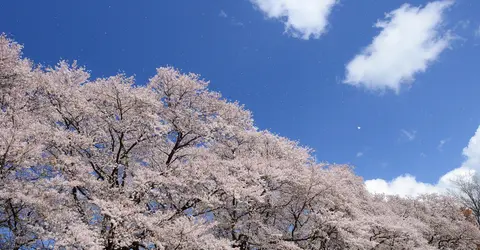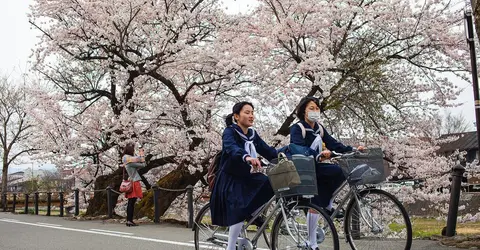The symbolism of cherry blossoms in Japan
- Published on : 20/11/2019
- by : Ph.L
- Youtube

Cherry trees at peak bloom
SoichiMasuhara
A thousand-year-old symbol
Traditionally associated with the hanami festivities, the cherry blossom is a very important symbol for the Japanese. Much more than just a flower, it's part of an age-old philosophy and today, the emblem of an entire nation.
A philosophical symbol
It was at the time Heian (794-1185) that the tradition of hanami appears in Japan. Literally, "contemplation of flowers", hanami usually involves admiring the cherry blossoms with family and friends during late March-early April as one of Japan's favorite activities.
The tradition of modern-day hanami is quite different from its original concept. The tradition has evolved over the years as the original idea of hanami was philosophical, interpreted as changing of the season to divine the year's harvest, sakura became to embody wabi-sabi and the Shinto ideals of impermanence, hope, and renewal and now, one of Japan'smost iconic natural symbol.

Hanami, a moment of conviviality
Fick/ kawabata
Inherited from the philosophy of Monono Aware "the pathos of things", hanami indeed advocates the beauty of impermanence.
A friendly moment with his neighbor at the table, a child's laughter under the flowering trees, or petals flying away in the sandstone of the wind, the contemplation of sakura is an event that is cherished in moments. It's an event that takes place once a year for a short period, and the idea is to savor every moment before it disappears. Just like the cherry blossoms themselves, birth and death in the blink of an eye.
With an average lifespan of two weeks, the sakura has indeed been the very personification of impermanence. Their petals can only be admired in a very short period, and their lightning passage on earth offers enlightenment or "satori " to those who admire them and provide meaning to their mortality. It is this mirror effect that thus promotes introspection, and which has made hanami an event in the calendar highly prized by artists and philosophers alike.

La rentrée sous les cerisiers
Flick/ ThirtyFive Millimeter
The flower of renewal
During the Heian period, the cherry blossom symbolized the passage of time and the transience of life, today the flowering of cherry trees is a moment of introspection towards the future. And for good reason, the sakura bloom just before April , a very important month in Japan!
Commencement of the new school year and the coming of spring, the cherry blossom is a symbol of renewal and brighter days ahead. Schoolchildren are accustomed to sakura waltzing in the wind as they head back to school, and young, newly hired employees admire them from their desks as the season marks the start of the new fiscal year in Japan.
As for the Japanese, the cherry blossom is a symbol of hope and comfort during the second World War.
Perceived as a familiar symbol for the Japanese, it was then taken up by the government of the time to unify a nation weakened by war. Whether in the form of metaphors in political speeches or drawings of kamikaze bombers, sakura is becoming ubiquitous on the archipelago. It symbolizes a strong and united people and forming the hopes of an entire nation.
At once familiar and intriguing, docile but elusive, is first associated with the allies of the Emperor during the civil war of 1868, before being taken by the Meiji government (868-1912) to establish its identity and dominance in several colonized countries such as Korea and Taiwan. Thousands of cherry trees were planted during this period and still exist today.
A national identity symbol
Poetic and philosophical, the cherry blossom is the identity and symbol of the archipelago. The symbol of the Japanese government since the Nara period (710-794)!
Originally chosen to stand out from China whose emblem was the plum blossom, the cherry blossom has since been the subject of many diversions throughout Japanese history.
This unique identity of the cherry blossom has been preserved over the ages. And even today, the sakura is the international symbol of Japan as it is offered as a diplomatic gift when officials are invited abroad.
Seduced by cherry blossoms? Get the Japan Rail Pass to travel smart throughout Japan to discover sakura.















